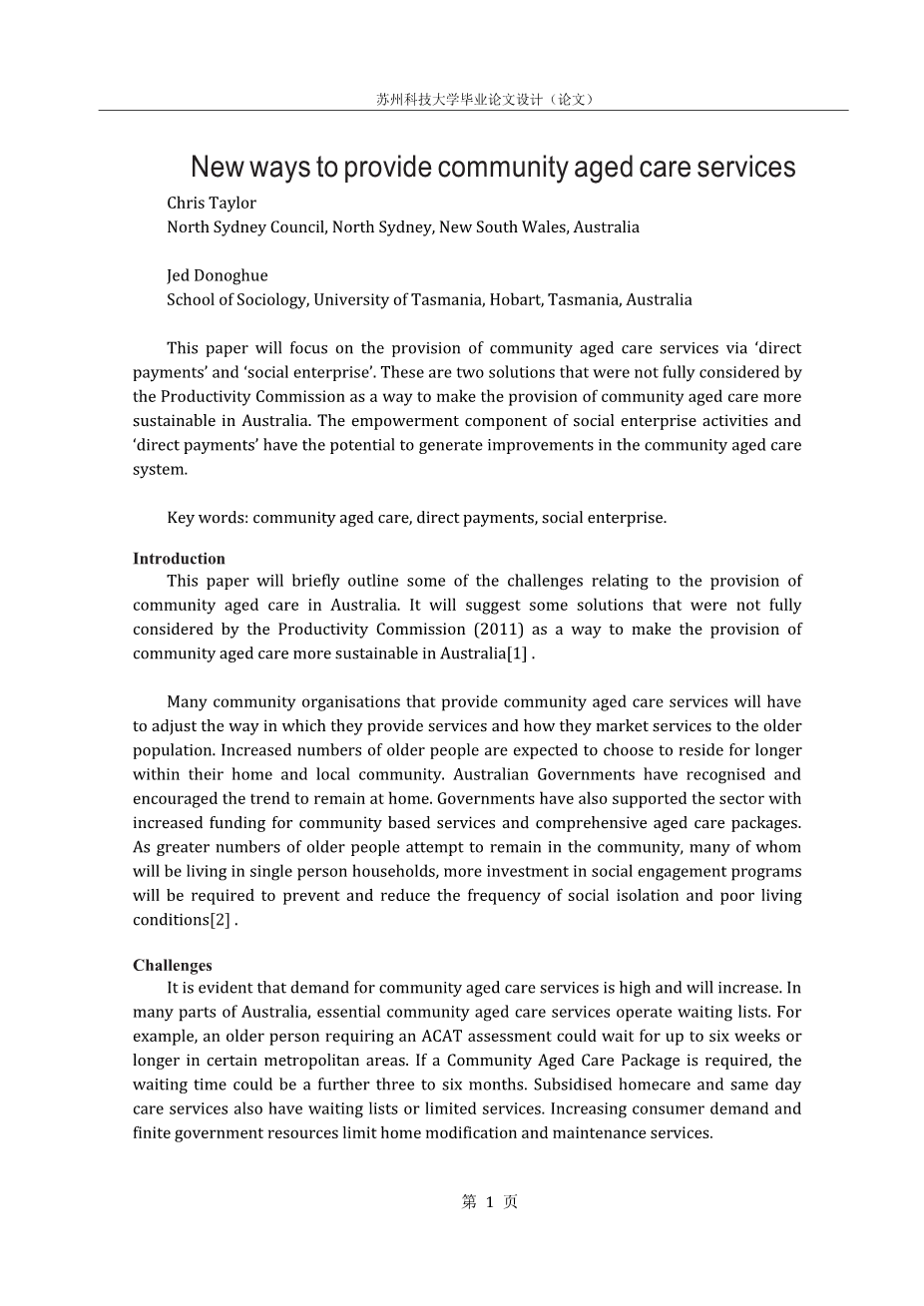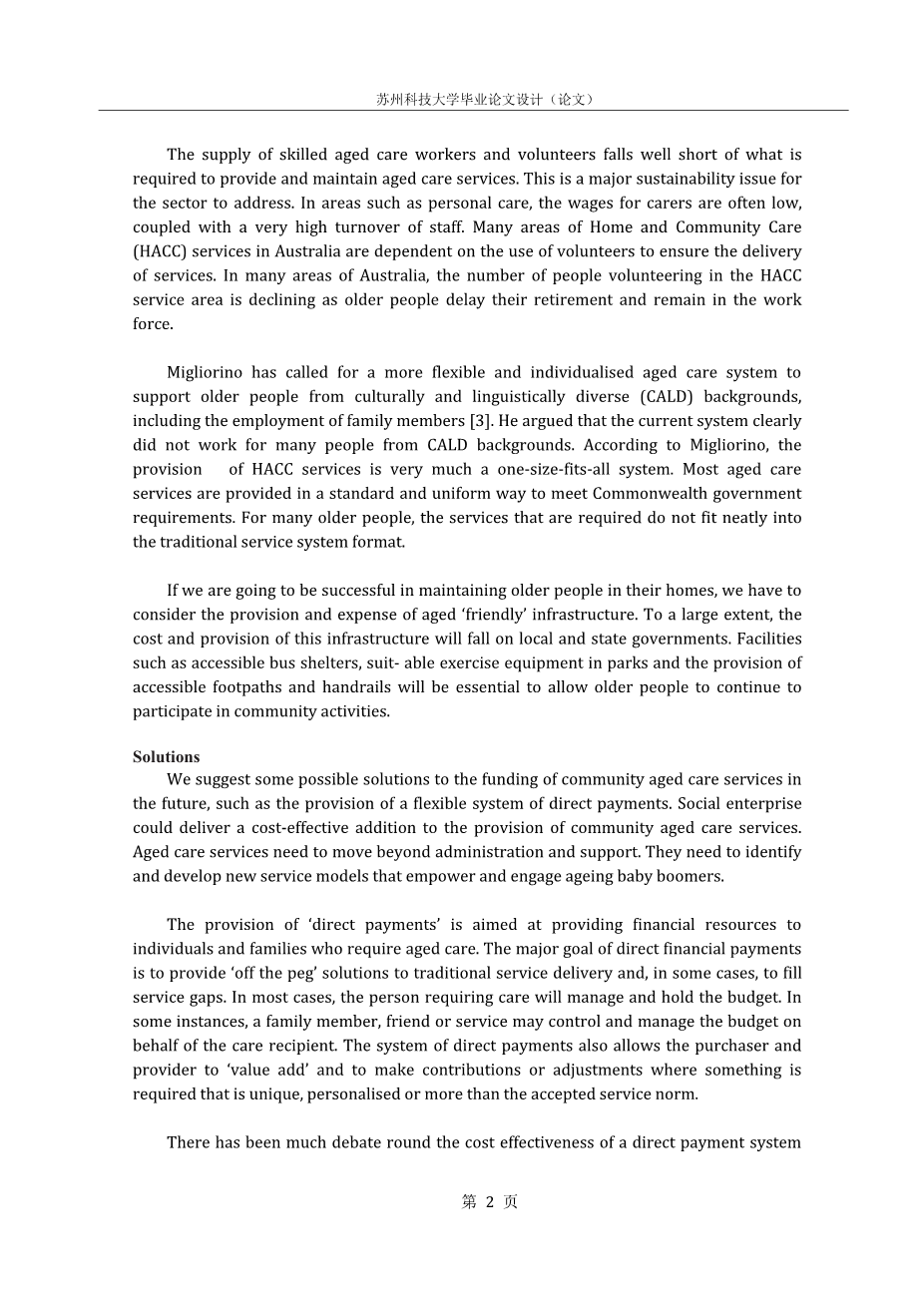New ways to provide community aged care services
Chris Taylor
North Sydney Council, North Sydney, New South Wales, Australia
Jed Donoghue
School of Sociology, University of Tasmania, Hobart, Tasmania, Australia
This paper will focus on the provision of community aged care services via lsquo;direct paymentsrsquo; and lsquo;social enterprisersquo;. These are two solutions that were not fully considered by the Productivity Commission as a way to make the provision of community aged care more sustainable in Australia. The empowerment component of social enterprise activities and lsquo;direct paymentsrsquo; have the potential to generate improvements in the community aged care system.
Key words: community aged care, direct payments, social enterprise.
Introduction
This paper will briefly outline some of the challenges relating to the provision of community aged care in Australia. It will suggest some solutions that were not fully considered by the Productivity Commission (2011) as a way to make the provision of community aged care more sustainable in Australia[1] .
Many community organisations that provide community aged care services will have to adjust the way in which they provide services and how they market services to the older population. Increased numbers of older people are expected to choose to reside for longer within their home and local community. Australian Governments have recognised and encouraged the trend to remain at home. Governments have also supported the sector with increased funding for community based services and comprehensive aged care packages. As greater numbers of older people attempt to remain in the community, many of whom will be living in single person households, more investment in social engagement programs will be required to prevent and reduce the frequency of social isolation and poor living conditions[2] .
Challenges
It is evident that demand for community aged care services is high and will increase. In many parts of Australia, essential community aged care services operate waiting lists. For example, an older person requiring an ACAT assessment could wait for up to six weeks or longer in certain metropolitan areas. If a Community Aged Care Package is required, the waiting time could be a further three to six months. Subsidised homecare and same day care services also have waiting lists or limited services. Increasing consumer demand and finite government resources limit home modification and maintenance services.
The supply of skilled aged care workers and volunteers falls well short of what is required to provide and maintain aged care services. This is a major sustainability issue for the sector to address. In areas such as personal care, the wages for carers are often low, coupled with a very high turnover of staff. Many areas of Home and Community Care (HACC) services in Australia are dependent on the use of volunteers to ensure the delivery of services. In many areas of Australia, the number of people volunteering in the HACC service area is declining as older people delay their retirement and remain in the work force.
Migliorino has called for a more flexible and individualised aged care system to support older people from culturally and linguistically diverse (CALD) backgrounds, including the employment of family members [3]. He argued that the current system clearly did not work for many people from CALD backgrounds. According to Migliorino, the provision of HACC services is very much a one-size-fits-all system. Most aged care services are provided in a standard and uniform way to meet Commonwealth government requirements. For many older people, the services that are required do not fit neatly into the traditional service system format.
If we are going to be successful in maintaining older people in their homes, we have to consider the provision and expense of aged lsquo;friendlyrsquo; infrastructure. To a large extent, the cost and provision of this infrastructure will fall on local and state governments. Facilities such as accessible bus shelters, suit- able exercise equipment in parks and the provision of accessible footpaths and handrails will be essential to allow older people to continue to participate in community activities.
Solutions
We suggest some possible solutions to the funding of community aged care services in the future, such as the provision of a flexible system of direct payments. Social enterprise could deliver a cost-effective addition to the provision of community aged care services. Aged care services need to move beyond administration and support. They need to identify and develop new service models that empower and engage ageing baby boomers.
The provision of lsquo;direct paymentsrsquo; is aimed at providing financial resources to individuals and families who require aged care. The major goal of direct financial payments is to provide lsquo;off the pegrsquo; solutions to traditional service delivery and, in some cases, to fill service gaps. In most cases, the person requiring care will manage and hold the budget. In some instances, a family member, friend or service may control and manage the budget on behalf of the care recipient. The system of direct payments also allows the purchaser and provider to lsquo;value addrsquo; and to make contributions or adjustments where something is required that is unique, personalised or more than the accepted service norm.
There has been much debate round the cost effectiveness of a direct payment system and how engaging and flexible it might be. Leadbeater and colleagues found that traditional services can cut clients off from the r
全文共10735字,剩余内容已隐藏,支付完成后下载完整资料


英语译文共 7 页,剩余内容已隐藏,支付完成后下载完整资料
资料编号:[453287],资料为PDF文档或Word文档,PDF文档可免费转换为Word
以上是毕业论文外文翻译,课题毕业论文、任务书、文献综述、开题报告、程序设计、图纸设计等资料可联系客服协助查找。


